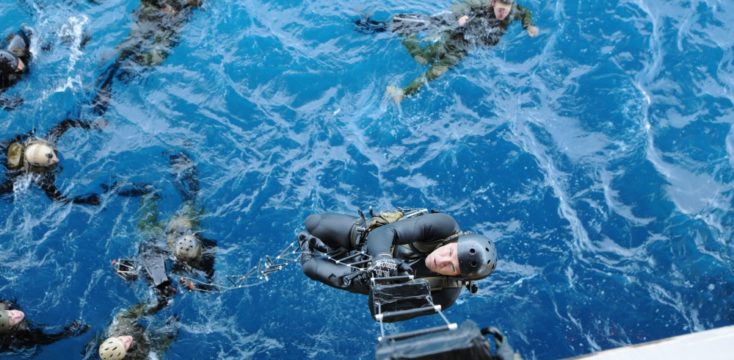
Article written by Stavros Atlamazoglou and orginally published by Sandboxx.
The Navy is offering big bonuses for eligible Navy SEAL and Special Warfare support officers.
SEAL and Special Warfare support officers who are looking to extend their contract can earn bonuses ranging from $15,000 to $125,000, depending on a few criteria.
First, only officers with the 1130 (Unrestricted Line Officer billet requiring Special Warfare (SEAL) qualification) and 1137 (Unrestricted Line Officer billet for full-time Special Warfare support) are eligible for the bonuses. Second, the officer has to have a minimum of 15 years in active duty to qualify.
According to a Navy release, the bonuses are divided into two categories (Phase 1 and Phase 2) and have two options (5-year and 3-year contracts).
Phase 1 bonuses are for officers with at least 15 years and can reach up to $125,000 for SEAL officers and $60,000 for Special Warfare support officers, depending on if they screened successfully for an executive officer (XO) slot.
Phase 2 bonuses are for officers with between 20 and 22 years and can reach up to $75,000 for SEAL officers and $36,000 for Special Warfare support officers.

This isn’t the first time that the Navy, or indeed any branch, has offered substantial monetary bonuses to special operators in order for them to reenlist. Earlier in the year, the Army was offering qualified Special Forces warrant officers up to $100,000 bonuses in an attempt to retain their expertise. The 75th Ranger Regiment has also launched similar retention initiatives in the past couple of years.
The relative lull in combat operations now that the wars in Afghanistan, Iraq, and Syria are on the backburner has gotten many officers and enlisted in the special operations community thinking about their future. A wartime military is quite different from one during peacetime. After months and years of selections, training, and pre-deployment workups, it’s only natural that special operators want to use their hard-earned skills in active operations. And when there isn’t room for everyone – some units still get to see combat – the civilian option starts to sound more and more alluring. Civilian opportunities often come with better financial compensation and advancement prospects, but also at the cost of job security. Some try to balance the two worlds by joining a reserve or National Guard special operations unit while others get out altogether.
If a SEAL officer decides to get out at around the 15-year mark (a bit uncommon considering that retirement is only five years away) it will probably be because he couldn’t pass the board for commander (O5). Nevertheless, his prospects outside the military would be promising, especially if he has completed a masters degree, something that often happens between the 15 and 17 year mark.
There are four different traditional paths to becoming a Navy SEAL officer: Graduate from the Naval Academy (midshipmen would have to also pass a week-long mini-BUD/s to qualify from this route); Graduate from an accredited university’s Naval Reserve Officer Training Program (NROTC); Graduate from the Navy’s Officer Candidate School (OCS), or lateral transfer from another service. All programs present a level of difficulty, both of getting to and completing BUD/S.
Part of Naval Special Warfare, SEALs and Special Warfare Combatant-Craft Crewmen (SWCCs) are America’s maritime special operations force.
Author Stavros Atlamazoglou is a Greek Army veteran (National service with 575th Marines Battalion and Army HQ). Johns Hopkins University. You will usually find him on the top of a mountain admiring the view and wondering how he got there.







